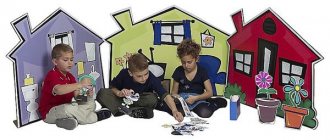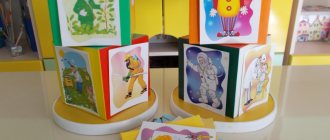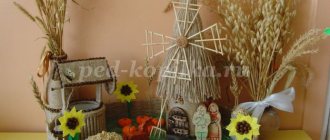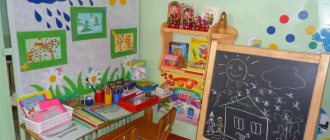Formation of a child’s creative personality through theatrical activities
Content:
1. The relevance of this problem.
2. Goals and objectives of the work on the formation of the child’s creative personality through theatrical activities.
My practical experience in performing these tasks:
a) Organization and design of a developing subject-spatial theatrical environment.
b) Acquaintance with the basics of theatrical culture, with the main types of theatrical art.
c) Work on sketches, rhythmoplastics, staging performances.
Conclusion.
List of used literature.
Appendix A Work plan for the Teremok theater group.
Appendix B Script for the play “Journey to the Autumn Forest.”
Appendix B Photo report “We and the theater.”
Appendix D General parent meeting "Let's save the planet together."
Appendix E Monitoring the effectiveness of using the methodology of theatrical activity in the preparatory group.
The current state of education in Russia is characterized by qualitative changes in the field of content, which are aimed at developing children's creative thinking and research abilities. Today, when the problem of preschool education is being widely and fundamentally solved and the tasks facing teachers of preschool educational institutions are becoming more complex, the task of developing the creative abilities of children, the idea of introducing them to fiction and theatrical activities remains very important.
Children's creativity is one of the pressing problems of preschool pedagogy and child psychology. She was examined by L.S. Vygotsky, A.N. Leontyev, L.I. Wenger, N.A. Vetlugina, B.M. Teplov, O.M. Dyachenko, A.I. Volkov and many others.
Theatrical activity is the most common type of children's creativity. It is close and understandable to the child, lies deeply in his nature and is reflected spontaneously, because it is connected with play. From a very early age, the child strives for creativity. Therefore, it is so important to create an atmosphere of free expression of feelings and thoughts in the children's team, to awaken the imagination of children, and to try to realize their abilities to the maximum.
Theatrical activities help develop the interests and abilities of the child, promote general development, the manifestation of curiosity, the desire to learn new things, the assimilation of new information and new ways of acting, the development of associative thinking, perseverance, determination, the manifestation of general intelligence, emotions when playing roles. In addition, theatrical activities require the child to be decisive, systematic in work, and hardworking, which contributes to the formation of strong-willed character traits. The child develops the ability to combine images, intuition, ingenuity and creativity, and the ability to improvise. Theatrical activities and frequent performances on stage in front of audiences contribute to the realization of the child’s creative powers and spiritual needs, emancipation and increased self-esteem.
Theatrical activity, like no other type of activity, contributes to the development of a child’s communication skills. Theatrical play presupposes, first of all, the acceptance of a situation of equal positions, positions of complicity and cooperation, partnership (dialogue) between an adult and a child.
The teacher’s task is to help the child master various methods of understanding natural science, art, and life reality, to be able to choose the appropriate tool (to configure himself) that allows him to act adequately to them, to change his role position: to contemplate these realities or act in them. This is facilitated by the alternation of the functions of performer and spectator, which the child constantly takes on in order to demonstrate his position, his skills, knowledge, and fantasies.
Theatrical activities should provide children with the opportunity not only to study and understand the world around them through comprehension of fairy tales, but to live in harmony with it, receive satisfaction from classes, variety of activities, and successful completion of tasks. Therefore, I strive to create such an atmosphere, an environment for children so that they can play with pleasure and comprehend the amazing magical world, the name of which is theater!
For four years I have been working on the topic “Formation of a child’s creative personality through theatrical activities.” The goal that I set when teaching theater arts to children is to make the lives of students interesting and meaningful, filled with the joy of creativity. Every child is talented from the very beginning, and our theater provides an opportunity to identify and develop in a child what is inherent in him from birth. The sooner you start working with children to develop their creative abilities through the means of theatrical art, the greater results can be achieved in song, dance and play creativity.
Working on this topic, I set the following tasks:
Study of theoretical and practical experience on this topic
Organization and design of a developing subject-spatial theatrical environment
Working on children’s speech culture and technique
Acquaintance with the basics of theatrical culture, with the main types of theatrical art
Work on sketches, rhythmoplasty, staging performances
The methodological foundations of my work are based on such essential aspects of theater as:
simulation game, creation and exploration of imaginary reality;
role-playing game;
games with objects;
a model of combining individual and collective creativity, with its own strict organization and self-regulation;
model of process deployment from concept to implementation;
interaction of ideas (or versions) and the birth of a new one on their basis;
consideration of the idea from different sides - from different language spaces (in kindergarten - this is the principle of studying one phenomenon through the prism of various educational activities).
actualization of the unfamiliar;
impact on the student’s feelings and involvement in the game process.
Having studied the theoretical and practical experience of N.D. Sorokina, A.V. Shchetkina, L.Ya. Polyak, L.G. Kireeva, I.V. Bodrachenko, T.N. Karamanenko and other authors of popular methodological literature in the field of theatrical activities for preschoolers, working on the “Program of Education and Training in Kindergarten” edited by M.A. Vasilyeva, I drew up a work plan for my theater group, starting with the second junior group (Appendix A).
Theater classes in the Teremok club I organized are designed for children from 3 to 7 years old. Classes are held once a week for 25 minutes. The number of children in the group is 15-20 people.
The main form of classes is group. The circle’s work plan also involves other forms of work - individual and subgroup classes, which are used to practice individual scenes of performances.
The work plan of the circle consists of five sections:
“Theater game” is aimed at developing children’s play behavior, developing the ability to communicate with peers and adults in various life situations.
“Transformers” - games that develop the ability to transform;
Theatrical games to develop imagination and fantasy;
“Living Fairy Tale” - dramatizations of poems, stories, fairy tales;
“Rhythmoplasty” includes complex rhythmic, musical, plastic games and exercises designed to ensure the development of natural psychomotor abilities of preschool children, their acquisition of a sense of harmony of their body with the outside world, the development of freedom and expressiveness of body movements.
Exercises to develop motor abilities, dexterity and mobility;
Games to develop a sense of rhythm and coordination of movements, plastic expressiveness and musicality;
Musical and plastic improvisations;
“Culture and technique of speech” - combines games and exercises aimed at improving speech breathing, developing correct articulation, intonation expressiveness and speech logic, and preserving the Russian language.
Exercises to develop speech breathing, diction, articulatory gymnastics;
Games that allow you to develop intonational expressiveness of speech (learn to use different intonations), expand the figurative structure of speech;
“Let’s make up a fairy tale together”;
Games and exercises aimed at improving speech logic.
“Fundamentals of Theatrical Culture” is designed to provide conditions for preschoolers to acquire basic knowledge about theatrical art. Children receive answers to questions:
What is theater, theatrical art;
What kind of performances are there in the theater?
Who are the actors;
What transformations take place on stage;
How to behave in the theater;
“Work on a play” is based on the author’s scripts and includes the topics “Getting to know the play” (joint reading) and “From sketches to performance” (choosing a play or dramatization and discussing it with children; working on individual episodes in the form of sketches with improvised text; searching for a musical and plastic solution to individual episodes, staging dances; creating sketches and scenery; rehearsing individual paintings and the entire play; premiere of the play; discussing it with children). Parents are widely involved in working on the play (helping with learning the text, preparing scenery and costumes).
Participation in skits, performances and theatrical events.
Preparation of scenery, props, posters (we design, draw, glue ourselves!).
Work on the sections of the circle plan continues throughout the entire education of children. The content of the sections expands and deepens depending on the stage of training.
To implement the plan, it was necessary to create and design a subject-development environment for the theater studio. My colleagues and parents gave me a lot of help in this. With the help of parents, we made large-sized construction kits that were appropriate for the child’s height (Appendix B), sewed a mini-screen, made various masks, costumes, and attributes for children’s performances, and purchased audio recordings of fairy tales and musical works.
The first type of theatrical activity in our circle that I introduced the children to was puppet theater. The conventions of puppet theater are close to children, they are accustomed to it in their games, which is why the children so quickly joined the performance: they answered the puppets’ questions, warned about danger, carried out their instructions, and gave advice.
My students enjoyed watching puppet theater performances performed by me (“Turnip”, “Teremok”, “Kolobok”, etc.), as well as performed by second-grade students of our school.
Then we started the next stage - working on sketches. Children of the second youngest group acted out the well-known Russian folk tales “Masha and the Bear”, “Zayushkina’s Hut” and others with tabletop dolls (toy theater), with pictures on cardboard, on flannelgraph (picture theater). She also successfully used elements of theatrical activity in educational classes. For example, in mathematics classes, the children’s favorite Dunno (a toy of the Bi-ba-bo theater) was a frequent guest; in classes on speech development, he learned pure sayings and physical exercises, Bunny (spoon theater); in classes on getting to know the outside world, I used a shadow theater (hare, dog, goose). Subsequently, the children's favorite toys, brought from home, were frequent guests in our classes.
The next stage of my work was theatrical acting and rhythmoplasty. Rhythmoplasty includes complex, rhythmic, musical, plastic games and exercises that ensure the development of children’s natural psychomotor abilities, freedom and expressiveness of body movements. For this purpose, the games “Vanechka”, “Loaf”, “Guess the Animal”, “Sea Figure” and others were used in physical education and music classes. These games teach you to hear rhythm, develop coordination of movements, speech breathing, varied intonation, teach you to remember various poses and convey them, and create the image of an animal using expressive plastic movements.
Very little time passed, and from spectators my students turned into actors. By the age of four, the children began to actively take part in theatrical productions for the holidays. At the New Year's party they successfully debuted in the roles: Hare - Styopa Popov, Fox - Vika Zaichikova, Bear - Andrey Karelin. At the matinee dedicated to the holiday of March 8, loud applause and smiles were awarded to the dramatization of the poems: “Caprice” - Nastya Lavrentyeva and Artyom Alexandrov, “Naughty” - Nikita Lebedev and Maxim Semyonov, “Mom’s Labor” - Misha Gudz and Alisa Bessonova, “Today Mother's Day" - Katya Korovkina and Vika Nikolaeva, "Tea Party" - Liza Ledashcheva, Katya Korovkina, Nikita Lebedev, Vika Nikolaeva and Katya Veretennikova.
Achieving good results in the performance of poetry, mini-skits, dramatization of fairy tales, and musical performances was facilitated by systematic work on the development of culture and speech technique in theater classes, during which children learned:
Change the pitch and strength of the voice according to the teacher’s instructions
Pronounce tongue twisters and tongue twisters clearly at different rates
Read a poetic text by heart, pronouncing the words correctly and placing logical emphasis
Build a dialogue with a partner on a given topic
Say a long phrase or quatrain in one breath
Choose a rhyme for a given word
Saying the same phrase with different intonations
Compose a dialogue between fairy-tale characters
All these exercises for the development of speech, breathing and voice improve the child’s speech apparatus. Completing game tasks in the images of animals and characters from fairy tales helps you better master your body and understand the plastic possibilities of movements. Theatrical games and performances allow children to immerse themselves in the world of fantasy with great interest and ease, and teach them to notice and evaluate their own and others’ mistakes. Children become more relaxed, sociable, learn to clearly formulate their thoughts and express them publicly, feel and understand the world around them more subtly.
Before starting to stage performances, I decided to introduce the children to the structure of the theater from the outside and inside. To do this, we went to the Teremok puppet theater on an excursion. The guide told the children about theatrical professions: make-up artist, costume designer, lighting designer, sound engineer, and took them behind the scenes of the theater, where she told and showed how dolls are created and who restores them. The children were especially delighted by the doll storage room, where a huge number of dolls of different types were collected (life-size, puppets, on a puppet, and others), with which the children not only met, but also took photographs as a souvenir (Appendix B).
My children and I repeatedly went to the Teremok Theater to see the performances “Fun School,” “Little Red Riding Hood,” and “The Little Goose.” The children watched the performances with great pleasure, discussed them, but with even greater delight they began to participate in the theatrical game.
The next stage of our work with children was the actual production of performances.
It is during the staging of performances that one can very clearly see how previously vulnerable and insecure children become bolder, more decisive, and take a more active position in life. Successful experience on stage contributes to successful communication in life.
I believe that in order to create a magical theatrical world, it is not at all necessary to have a large stage, exquisite scenery, or an abundance of costumes. For us, this is a spacious room in our own kindergarten, decorations invented and drawn together with the children, costumes made together with the parents (Appendix B). For us, this is a place where children study with pleasure, in an atmosphere of creativity, play and art.
The main thing, in my opinion, is the joint desire to play a fairy tale, first for ourselves and then for the audience. And we have such a desire! And the result of our work is wonderful productions.
Without setting out to examine in detail the lesson notes for preparing and staging the performance, I will only touch on its main stages.
Lesson 1. Work on the play “Journey to the Autumn Forest”
Purpose: To introduce children to the text of the play and discuss it; awaken the ability to compassion, a sense of justice, strive to do good.
Progress of the lesson:
Familiarization with the text of the play.
After reading the play, the teacher talks with the children: “Who did you like in this play? Which character did you like best and why? Why were the forest inhabitants alarmed? etc."
Game "Associations". The teacher invites the children themselves to assign roles, based on associations. (Who can play a hedgehog? Which of the guys is associated with him? Who can best portray him? Etc.)
Preliminary distribution of roles at the request of the children. Summing up the lesson.
Lesson 2. Rhythmoplasty
Goal: To develop a sense of rhythm, speed of reaction, coordination of movements, learn to create images of animals using expressive plastic movements.
Progress of the lesson:
Organizing time.
Exercise “Don’t make a mistake” (The teacher alternates clapping, tapping the foot and clapping on the knees in different combinations, changing the rhythm and tempo).
Creation of animal images. (The teacher invites all the children, to the music, to portray the image of a hedgehog, hare, squirrel, bear, fox, wolf using plastic movements. Then only those children who are approved for these roles portray, and the rest evaluate.)
Summing up the lesson.
Lessons 2-4. Working on the play. Learning songs.
Goal: To learn songs and musical parts of the characters in the play, to develop attention, a sense of rhythm, facial expressions and gestures.
Progress of the lesson:
Organizing time.
Listening to and learning musical pieces used in the play (the song “Oh, what an autumn”, “Autumn”, “Autumn the Artist”, “Goodbye to the Autumn Forest”, ditties).
Individual learning of the musical parts of the characters in the play (squirrel song, fox romance, hedgehog waltz, wolf song, bear song).
Summing up the lesson.
Lessons 5-6. Working on the play.
Goal: To learn the text of the play with children, paying attention to the work of the articulatory apparatus, breathing, and voice. Improve children's attention, imagination, memory, and communication.
Progress of the lesson:
Exercises for lips, tongue, facial muscles, neck.
Work on text and speech technique.
Improvisation of performance episodes.
Summing up the lesson.
Lessons 7-8. Working on the play. Making decorations.
Goal: Make the scenery for the play, decide what costumes each of the characters will wear. Assign responsibility for props, scenery, and costumes.
Progress of the lesson:
Organizing time.
Making decorations. (Together with me, the guys made trees from colored paper and self-adhesive film. During the lesson, animal headdresses were also made, and the kids prepared costumes with their parents at home.)
Individual rehearsal of the words of the main characters of the play.
Summing up the lesson.
Lessons 9-10. Working on the play. Learning dances.
Goal: To learn the dances and musical parts of the characters in the play, to develop attention, a sense of rhythm, facial expressions and gestures.
Progress of the lesson:
Organizing time.
Learning the dance with autumn leaves and “Polka”.
Rehearsal of musical works. Rhythmoplasty.
Summarizing.
Lessons 11-16. Working on the play.
Goal: To rehearse all episodes of the performance using scenery, costumes, musical accompaniment, and lighting.
Progress of the lesson:
Organizing time.
Rehearsal of the play.
Summing up the lesson.
Premiere of the play “Journey to the Autumn Forest”
Conclusion
I consider the result of my work to be the fact that thanks to the theater club, children learned to listen and hear each other, formulate and express their thoughts publicly. Frequent performances on stage in front of audiences contributed to emancipation and increased self-esteem in children. The guys became friendlier and more united. This was noted not only by teachers, but also by parents, who repeatedly expressed words of gratitude to us.
Summarizing all of the above, I believe that working on the topic “Formation of a child’s creative personality through theatrical activities” gave me the opportunity to create an atmosphere of free expression of feelings and thoughts in a children’s group, to awaken the imagination of children, to fully realize their creative abilities, when every child is able to progressed from level to level of his capabilities, and eventually achieved certain heights. This can be confirmed by the results of monitoring carried out at all stages of application of this technique, which makes it possible to track the positive dynamics of the development of the child’s creative personality (Appendix E).
I consider the best evidence of the effectiveness of my work: the successful admission of students to educational institutions of various types (schools, gymnasiums, lyceum classes), the reduction of the adaptation period at the first stage of education and the sincere gratitude of parents.
And I firmly believe that the expended strength of my soul will return to me through the successes and victories of my students!






